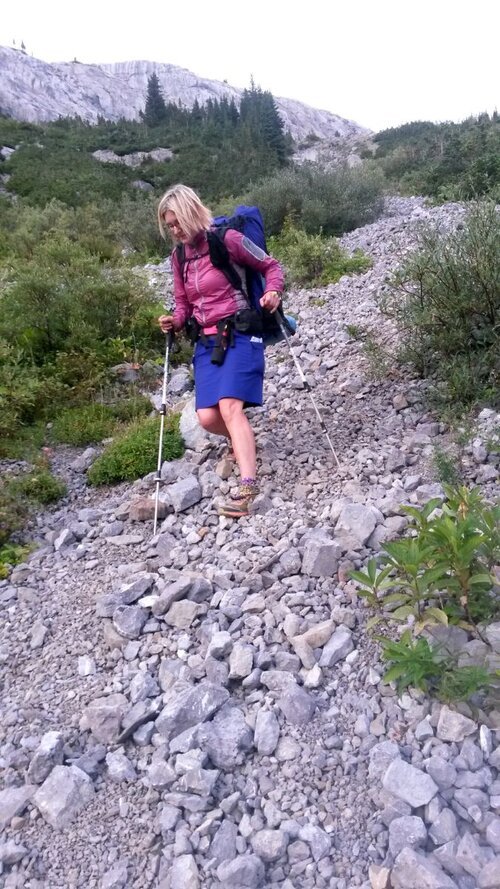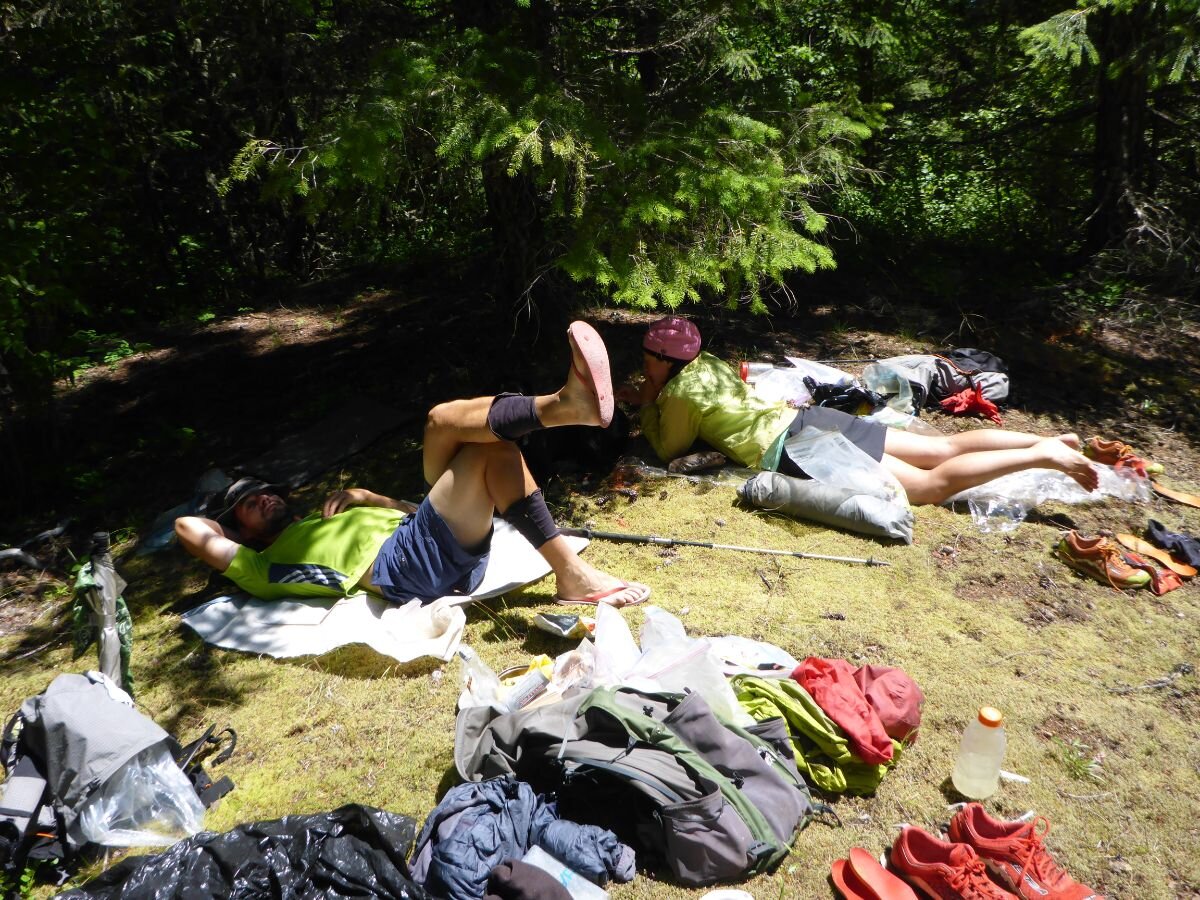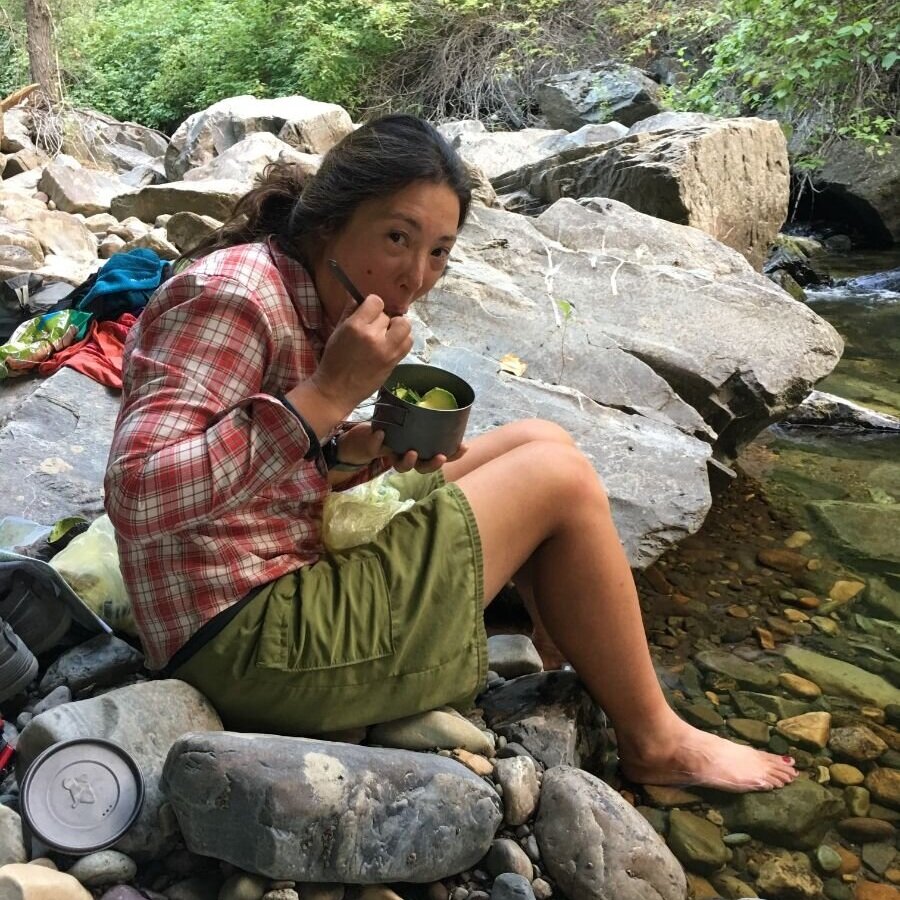How To Take Care Of Your Feet When Hiking And Backpacking
14 Tips from Hikers with a Combined 100,000 Miles of Thru Hiking
May 30th, 2023
Treeline Review writer Felicia Hermosillo elevates her feet during a snack break on the Idaho Centennial Trail. Photo by Naomi Hudetz
While we wish perfectly fitting hiking socks with perfectly fitting shoes meant you'd never have a foot problem again, that just isn’t reality. There is no magical pair of socks (or sock + hiking boot or hiking shoe combination) that will prevent blisters or hiker foot injuries altogether.
Almost every hiker gets a blister and sore feet at some point. That said, the saying “an ounce of prevention is worth a pound of cure” certainly applies to foot care. Our team of writers with a combined 100,000 miles of hiking under their belt, shares some tips for how to take care of your feet while hiking and backpacking.
We create reader-supported, objective, independently-selected gear reviews. This story may contain affiliate links, which help fund our website. When you click on the links to purchase gear, we may get a commission — without costing you an extra cent. Thank you for supporting our work and mission of outdoor coverage for every body! Learn more.
1.Prep Your Feet Before You Head Out
Before you leave for your hiking trip, spend a little time getting your feet ready for what’s to come. A week or two before you leave, pre-condition your feet every night before bed. First, soak your feet in Epsom salts for a good 20 minutes. Next, condition your feet with a product like Trail Toes. Apply the product, rub it in well, and sleep with lightweight socks on your feet. You want your feet to be well moisturized and pliable.
In addition, trim your toenails straight across, not curved. This helps to avoid ingrown toenails. Don’t trim them too short.
It’s common to get rocks in your shoe, especially when on loose terrain. Here, Treeline Review editor Naomi Hudetz descending North Kananaskis Pass on the Great Divide Trail in the Canadian Rockies. Photo by Liz Thomas.
2. REMOVE ANYTHING YOU FEEL IN YOUR SHOE
Start with prevention. Don’t wait.
If you have a rock, pine needle, or any grit in your hiking boot, sock or shoe, no matter how big or how small, stop immediately and remove it.
Even the tiniest of rocks can wreak havoc on your feet. Plus, it can damage your sock or insole.
Light gaiters may help prevent grit from entering your shoe. Preventative foot care is the most important step in dealing with blisters and foot pain.
Best yet, this strategy doesn’t involve specialized gear.
3. STOP IF YOU FEEL A HOT SPOT
Again, don’t wait. If you feel a hot spot, stop immediately and deal with it: tape it with Leukotape, or apply some foot balm like Trail Toes lubricant or Gold Bond foot powder. A foot powder can also help manage trench foot or athlete's foot.
Try to keep your feet dry. A wet foot can sometimes be a source of rubbing that can lead to a hotspot. If you find yourself with wet socks and don't foresee your feet getting wet again, you may want to consider switching to dry socks to feel more comfortable.
If you’re desperate, try taking out your insole and see if it helps — especially if you’re using third-party insoles such as Superfeet. If the insoles take up too much volume or don’t fit you correctly, blisters can result. If I’m trying out new insoles, I’ll carry the stock insoles in my backpack until I know for sure that the new insoles will work for me.
Although it can be distracting to take a break while hiking, preventative foot care is important. Do whatever it takes to keep rubbing from turning into a blister or peeling skin.
Curious about hiking footwear? See our most popular Footwear stories:
Elevating legs and feet during a break is a quick fix for restoring energy and relieving some soreness from hiking. Here, Brian “Tomato” Boshart and Liz “Snorkel” Thomas take a break to dry out gear several hundred feet away from the trail during their thru-hike of the Chinook Trail. Photo by Whitney LaRuffa.
4. ELEVATE YOUR LEGS AND FEET
Studies show that elevating your legs and feet while you’re sitting or laying down can improve circulation and reduce swelling. It also helps to drain excess fluid build-up and return blood back to the heart.
It’s easy to find time during meal breaks or in your tent at night before going to sleep. Aside from blister prevention, elevating your legs may help manage foot pain or other hiking foot injuries. We’ve found that hammocks can be a comfortable and easy way to make sure your feet are elevated.
5. RINSE YOUR FEET
If you’re on a multi-day backpacking trip or thru-hike, rinse your feet whenever possible. Keep the dirt, dust, and grime to a minimum, and your feet will be happy. Only rinse downstream in natural sources (i.e., not water tanks in the desert) and never use soap directly in a water source. Use your hands or a bandana to remove stubborn grime. If you want to use soap to remove grime, use a biodegradable soap like Dr. Bronner’s (which we recommend in our Eco-Friendly Gear Swaps guide). We use by a water bottle or bag to wash 200 feet away from a water source.
Rinsing (or at least wringing out) your hiking socks can remove grit that over time, can cause rubbing. Photo by Naomi Hudetz.
6. RINSE AND ROTATE YOUR HIKING SOCKS
On a long hike like a multi-day backpacking trip or thru-hike, keep your hiking socks fresh by rinsing them in a natural water source (not water tanks in the desert, and ideally downstream in a moving source). Merino wool socks have natural antibacterial properties.
Never use soap of any kind. Turn them inside out and get the grime on the inside of your socks. Pin them to the outside of your pack to dry with diaper pins — we found out the hard way that diaper pins work better for actually keeping your socks attached than smaller safety pins.
Soaking feet in cold water for just 5 minutes can help reduce swelling. Photo by Naomi Hudetz.
7. SOAK YOUR FEET IN COLD WATER
If your feet are feeling swollen or fatigued, soaking them in cold water is the closest thing to a miracle cure we’ve found. Only soak in natural sources (not in water tanks in the desert) — the colder the better. Leave them in as long as you can stand.
And if you don’t have a natural source, you can place your full water bags (we like the CNOC bags or the Platy bags in our Best Water Bottles Guide) on the tops and bottoms of your feet — like the opposite of a hot water bottle. This is a strategy we’ve used on the Pacific Crest Trail and the Arizona Trail on sections far from water.
Drying wet socks on the Great Divide Trail. Photo by Liz Thomas
8. LET YOUR FEET AND SOCKS AIR DURING MEAL BREAKS
Just make it a habit — when you stop for lunch, take off your shoes and socks. Remove the insoles from your shoes, and put your shoes, socks, and insoles in the sun to dry out. A lot of recovery can happen during that 30-minute break.
Even when hiking in a dry climate, you can still find you’ve got a wet foot just from the sweat generated from hiking, especially if you are using a waterproof sock or waterproof hiking boots.
That's one reason why we recommend wearing a mesh trail runner or hiking shoe over a waterproof boot if you're going for a long hike.
Although not exactly foot-related, taking electrolytes and hydrating during your break may also make the rest of your body feel better, which could translate to happier feet.
9. PRE-TAPE YOUR FEET
If you have places on your feet that are prone to blisters because of prior blisters, put tape on them before you set out. Leukotape is the best tape we’ve found for this. Unlike moleskin, it stays on for multiple days (even when wet) but doesn’t hurt when you remove it. It moves the friction from your foot to the tape, and can make your walk much more comfortable.
10. MASSAGE YOUR FEET
At the end of a long day of hiking or backpacking, make it a habit to massage your feet. There’s evidence that massage reduces foot pain and inflammation — even if you only do it for 30 seconds — and my own hiker experience bears this out.
No matter how exhausted I am at the end of the day, I always massage my feet. If you don’t want to touch your feet with your hands, we like the self-care massage ball like the small cork roll-out balls by Rawlogy in our Essential Backpacking Accessories. We’ve had foot specialists recommend rolling our feet out with a golf or handball ball to address plantar fasciitis. Because they are made of cork, the Rawlogy balls have the same density at a fraction of the weight.
11. Use an Anti-Chafing Product
There’s no doubt about it — anti-chafing cream works. Hands down, my favorite product is Trail Toes. I pre-condition my feet with it before I leave, I apply it at night if my feet got wet during the day, and I use it during the day if I feel a hot spot. I also use it on my body if I’m feeling chafing elsewhere. It really is a miracle product.
12. Trim Your Toenails Properly
Trim your toenails straight across, not curved. In addition, don’t trim them too short. The nail should be even with the tips of your toes. Proper trimming helps to avoid ingrown toenails. I’ve had many ingrown toenails, and they are extremely painful. I’ve never had one since I started trimming my toenails this way.
13. Consider Using Support Insoles
Insoles, such as Superfeet, can help considerably with foot fatigue. I hiked the Arizona Trail in trail runners without special insoles, and I literally limped into Flagstaff because my feet were so sore. I hadn’t had that level of foot pain since my very first thru hike — the Pacific Crest Trail. I went straight to the outfitter and bought a pair of Superfeet.
We have an entire article dedicated to the benefits of wearing insoles.
Continental Divide Trail Thru-hikers taking a rest day in New Mexico. Photo by John Carr.
14. TAKE A BREAK
Sometimes, you may need a few days off your feet to allow the skin to heal and twitchy muscles to recover. If you’re on a backpacking trip or thru-hike, take a few rest days — either on or off-trail.
Try to walk as little as possible, keeping your feet elevated. You may want to consider icing them or keeping them cool.
If you’re on a thru-hike and taking a rest day in town, you may want to consider finding more comfortable hiking socks or hiking shoes. As we recommend in our Best Hiking Socks guide, switch out cotton socks for synthetic or merino wool. We like the Darn Tough Hiker Midweight or Swiftwick Flite XT Trail. Whatever you choose, know that both merino and synthetic fabrics can manage blister-causing moisture better than cotton socks.
You may want to experiment with a sock liner or a thicker sock with more cushion if you feel foot pain on your sole.
If you experience blisters between toes, consider toe socks, like the Injinji socks we recommended in our Best Hiking Socks guide.
Another common foot injury occurs when a toenail digs into the skin of an adjacent toe. Having a long toenail can also make it feel like your feet are too big for your shoe. Your toes may hit the toe box of your shoe, especially on downhills. We recommend carrying ultralight nail clippers in our Backpacking Essentials guide just for this reason.
It can be hard to take a break from the trail when you're excited about being outdoors. But listen to your feet. Give them a few days and you'll be back outdoors soon.
Looking for more tips on hiking? See our How to Get Started Hiking
Why you should trust us & about the author
Naomi Hudetz is a thru-hiker and co-founder of Treeline Review. She brings decades of private sector experience in project management, budget and pricing projection, and long-term business vision, strategy, and goals.
Naomi left her corporate career to pursue her passion for the outdoors. She received the Triple Crown award for hiking for completing the Appalachian Trail, Pacific Crest, and Continental Divide Trail and has hiked numerous other distance routes including the Great Divide Trail across the Canadian Rockies (twice), Grand Enchantment Trail, Pacific Northwest Trail, the Arizona Trail, (most of) the Idaho Centennial Trail, the first known thru-hike of the Blue Mountains Trail, and the Oregon Desert Trail.
She is former Treasurer of the American Long Distance Hiking Association-West and is based in White Salmon, Washington.
You can read all of Naomi’s Treeline Review stories on her author page.











